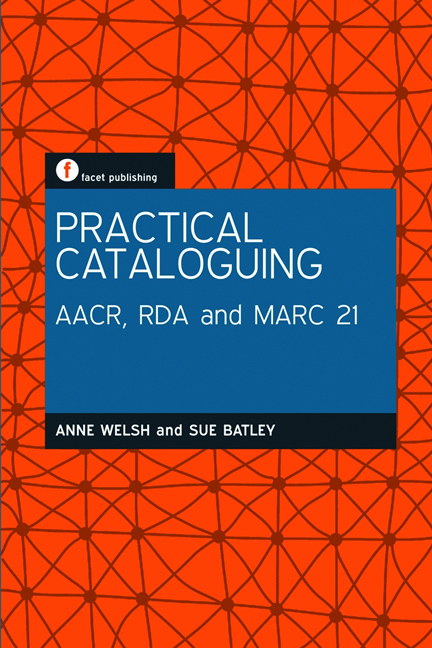Book contents
- Frontmatter
- Dedication
- Contents
- Acknowledgements
- Preface
- 1 Catalogues and cataloguing standards
- 2 The FRBRization of the catalogue
- 3 Bibliographic elements
- 4 Access points and headings
- 5 RDA: resource description and access
- 6 AACR and RDA
- 7 MARC 21
- 8 Practical cataloguing: bringing it all together
- 9 The birth of RDA and the death of MARC?
- 10 Examples
- References
- Index
- Frontmatter
- Dedication
- Contents
- Acknowledgements
- Preface
- 1 Catalogues and cataloguing standards
- 2 The FRBRization of the catalogue
- 3 Bibliographic elements
- 4 Access points and headings
- 5 RDA: resource description and access
- 6 AACR and RDA
- 7 MARC 21
- 8 Practical cataloguing: bringing it all together
- 9 The birth of RDA and the death of MARC?
- 10 Examples
- References
- Index
Summary
What is MARC 21?
The idea to use computers for cataloguing was developed by the Library of Congress from the 1950s. Various studies were carried out, resulting in the Machine Readable Cataloging (MARC) project; from 1966 Library of Congress MARC data was sent out to 16 libraries on tape (Chan, 2007). A similar initiative took place in the UK under the auspices of the British National Bibliography, and such was the success on both sides of the Atlantic that in 1968 the projects came together to form the MARCII format, an attempt to produce a standard AngloAmerican format (Bowman, 2007).
This attempt was only partially successful, and during the next 25 years over 50 different MARC formats developed across the world, including UKMARC and USMARC. Eventually, in 2001 the British Library ceased use and maintenance of the UKMARC format and adopted the harmonized US and Canadian format, MARC 21 (Bowman, 2007).
Lois Mai Chan (2007) identifies five current types of MARC 21 formats:
• MARC 21 for bibliographic data
• MARC 21 for authority data
• MARC 21 for classification data
• MARC 21 for holdings data
• MARC 21 for community information.
We have already looked at MARC 21 for authority data. This chapter considers MARC 21 for bibliographic data, which is used by many libraries for their catalogue records.
Essentially, MARC 21 for bibliographic data exists to provide a structure for catalogue records. The MARC 21 website describes it as a ‘communication format’ – it is a structure in which data from one computerized catalogue can be shared with another computerized catalogue.
Catalogue format, not cataloguing code
It is vital to understand that the MARC format provides the structure while other cataloguing codes provide the rules. Although the MARC website provides lots of useful examples, MARC 21 does not set out to be a cataloguing code. This is highlighted in the introduction to the format:
The content of the data elements that comprise a MARC record is usually defined by standards outside the formats. Examples are the International Standard Bibliographic Description (ISBD), AngloAmerican Cataloguing Rules, Library of Congress Subject Headings (LCSH), or other cataloging rules, subject thesauri, and classification schedules used by the organization that creates a record.
This chapter is designed to be used alongside MARC 21's website and AACR2, which is still the main cataloguing code used in libraries.
Information
- Type
- Chapter
- Information
- Practical CataloguingAACR, RDA and MARC 21, pp. 131 - 158Publisher: FacetPrint publication year: 2012
